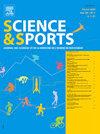Validation of the Vitruve for the back-squat movement with free weights
IF 0.8
4区 医学
Q4 SPORT SCIENCES
引用次数: 0
Abstract
Introduction
Although the “Vitruve” brand linear potentiometer has been validated for bench press, it needs to be validated for other sports movements such as squat to diversify its usefulness. Vitruve is claimed to be more accurate than Push, an independent accelerometer already validated for squats in general and specifically for back squats with free weights. As both devices have similar price tags, a comparison of these tools with a standard measurement (the video) will enable kinesiologists and fitness trainers to make an informed choice according to their needs. The aim was to validate the measurements obtained by Vitruve during the execution of a squat versus the Push and video analysis.
Key facts
Both the Vitruve and Push machines were attached to an Olympic bar with loads of 0%, 20%, 40%, 60% and 80% of the 1RM of two participants with a total of 180 repetitions (2 sets of 5 repetitions per load up to and including 60%, then 5 sets of 1 repetition at 80%). The mean and maximum velocities of the concentric phase of the two devices were recorded for the same repetition and then compared with kinematic analysis by video (60 Hz with the Kinovea tool). Data analysis shows strong correlations for mean velocity between Vitruve and Push versus video (respectively r = 0.73 and r = 0.76; P < 0.001) and a very strong Vitruve/Push correlation (r = 0.95, P < 0.001). The Bland and Altman plots show that both devices are more effective for average speeds below 1 m/s; but also that Vitruve should be preferred to Push for maximum speed assessment.
Conclusion
Vitruve offers more accurate speed training data than Push. It is therefore an additional, more accurate tool for trainers.
Introduction
Bien que le potentiomètre linéaire de marque « Vitruve » ait été validé pour le développé couché, il se doit d’être validé pour d’autres mouvements sportifs tel que le squat afin de diversifier son utilité. Le Vitruve est supposé plus précis que Push qui est un accéléromètre indépendant déjà validé pour le squat en général et spécifiquement pour le squat arrière avec poids libres. Les deux appareils ayant des prix similaires, une comparaison de ces outils avec une mesure étalon (la vidéo) permettra d’orienter les kinésiologues et préparateurs physiques dans un choix éclairé en fonction de leurs besoins. L’objectif était de valider les mesures obtenues par Vitruve lors de l’exécution d’un squat versus le Push et l’analyse vidéo.
Principales informations
Les deux appareils Vitruve et Push ont été fixés à une barre olympique avec des charges de 0 %, 20 %, 40 %, 60 % et 80 % du 1RM de deux participants avec un total de 180 répétitions (2 séries de 5 répétitions par charge jusqu’à 60 % inclusivement, puis 5 séries de 1 répétition à 80 %). Les vitesses moyennes et maximales de la phase concentrique des deux appareils sont enregistrées pour la même répétition et ensuite comparées à l’analyse cinématique par vidéo (60 Hz avec l’outil Kinovea). L’analyse des données montre pour la vitesse moyenne, de fortes corrélations sont observées entre le Vitruve et Push versus la vidéo (respectivement r = 0,73 et r = 0,76; p < 0,001) et une très forte corrélation Vitruve et Push (r = 0,95, p < 0,001). Les tracés Bland et Altman montrent que les deux appareils sont plus efficaces pour des vitesses moyennes inférieures à 1 m/s; mais aussi que le Vitruve serait à prioriser au Push pour évaluer la vitesse maximale.
Conclusion
Vitruve offre des données de suivi d’entraînement des vitesses plus précises que Push. Il constitue alors un outil supplémentaire et plus précis pour les entraîneurs.
验证Vitruve的后蹲运动与自由重量
虽然“Vitruve”品牌线性电位器已被验证用于卧推,但它需要验证其他运动动作,如深蹲,以多样化其用途。据称,Vitruve比Push更准确,Push是一种独立的加速度计,已经被证实可以用于一般的深蹲,特别是自由举重的后蹲。由于这两种设备的价格标签相似,将这些工具与标准测量(视频)进行比较,将使运动学家和健身教练能够根据他们的需求做出明智的选择。目的是验证Vitruve在执行深蹲与推和视频分析期间获得的测量结果。Vitruve和Push器械都连接在奥林匹克酒吧上,两名参与者的负荷分别为1RM的0%,20%,40%,60%和80%,总共重复180次(每次负荷2组5次,每次负荷高达60%,然后5组1次,每次负荷80%)。在相同的重复中记录两个装置的同心相位的平均和最大速度,然后通过视频(60 Hz,使用Kinovea工具)进行运动学分析比较。数据分析显示,Vitruve和Push与video的平均速度有很强的相关性(分别r = 0.73和r = 0.76);P & lt;0.001)和非常强的Vitruve/Push相关性(r = 0.95, P <;0.001)。Bland和Altman图显示,这两种装置在平均速度低于1 m/s时更有效;而且Vitruve应该优先于Push,以获得最大速度评估。结论vitruve提供的速度训练数据比Push更准确。因此,它是一个额外的,更准确的培训师的工具。IntroductionBien缆车potentiometre线性德品牌«Vitruve»河中的小岛高频valide pour le developpe尿布,il se doit理由valide倒其他所属的投产了电话分散经营者的儿子utilite蹲afin号。这是一个简单的例子,你可以用这个例子来证明你是一个成功的人,你可以用这个例子来证明你是成功的。两种不同的服装是相似的,一种不同的比较是相同的,一种不同的测量是相同的,一种不同的测量是相同的,一种不同的测量是相同的,一种不同的测量是相同的,一种不同的测量是相同的。“客观的、有效的、有效的”和“客观的、有效的、有效的”这两个词的意思是:“客观的、有效的、有效的、有效的”。螯informationsLes两appareils Vitruve等推动汽水机高频修复一个olympique用des费用0%,20%,40%,60%等杜80% 1 rm德两个参与者用联合国总180重复(2 de系列5重复par电荷一直inclusivement 60%,然后,5系德1重复了80%)。两件衣服的相同相位的最大尺寸为:1 .注册的 - - - - - - - - - - - - - - - - - - - - - - - - - - - - - - - - - - - - - - - - - - - - - - - - - - - - - - - - - - - - - - - - - - - - - - - - - -分析了不同年龄的人与不同年龄的人(分别r = 0,73和r = 0,76)之间的差异,分析了不同年龄的人与不同年龄的人之间的差异;p & lt;2001) et une trutris forte corcoration (r = 0,95, p <;0001)。英国的tracenys Bland和Altman设计了一套双件套,其设计效果为每隔1米/秒;我的意思是,我的工作是为了获得最大限度的成功,而不是为了获得最大限度的成功。结论:vitruve可有效地改善患者的生存期,改善患者的生存期,改善患者的生存期。将构成一个完整的系统,直到补充的和/或所有的和/或所有的。
本文章由计算机程序翻译,如有差异,请以英文原文为准。
求助全文
约1分钟内获得全文
求助全文
来源期刊

Science & Sports
社会科学-运动科学
CiteScore
1.50
自引率
18.20%
发文量
143
审稿时长
19.7 weeks
期刊介绍:
Science & Sports is a peer-reviewed journal, publishing worldwide high-quality and impactful papers of medical, scientific and applied technical research in the different fields of sports and physical activities: sport medicine, exercise physiology, sport physiology and performance, nutrition, traumatology relating to sport, rehabilitation or adapted physical activities. It facilitates the transfer of knowledge and technology between the clinic, research and practice in physical and athletic activity.
 求助内容:
求助内容: 应助结果提醒方式:
应助结果提醒方式:


